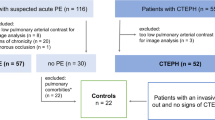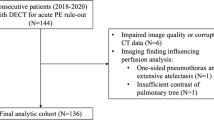Abstract
The study aimed to evaluate a quantification method of pulmonary perfusion with Dual-Energy CT Angiography (DE-CTA) normalized by lung density in the prediction of outcome in acute pulmonary embolism (PE). In this prospective study with CTA scans acquired with different breathing protocols, two perfusion parameters were calculated: %PBV (relative value of PBV, expressed per unit volume) and PBVm (PBV normalized by lung density, expressed per unit mass). DE-CTA parameters were correlated with simplified pulmonary embolism severity index (sPESI) and with outcome groups, alone and in combinationwith tomographic right-to-left ventricular ratios (RV/LV). PBVm showed significant correlation with sPESI. PBVm presented higher accuracy than %PBV In the prediction of ICU admission or death in patients with PE, with the best performance when combined with RV/LV volumetric ratio.





Similar content being viewed by others
Abbreviations
- DE-CTA:
-
Dual-Energy Computed Tomography Angiography
- DIBH:
-
Deep inspiratory breath hold
- ICU:
-
Intensive Care Unit
- PBV:
-
Perfused blood volume
- PE:
-
Pulmonary Embolism
- RVD:
-
Right ventricular dysfunction
- sPESI:
-
Simplified Pulmonary Embolism Severity Index
References
Barco S, Mahmoudpour SH, Valerio L, Klok FA, Münzel T, Middeldorp S, Ageno W, Cohen AT, Hunt BJ, Konstantinides SV (2020) Trends in mortality related to pulmonary embolism in the European Region, 2000-15: analysis of vital registration data from the WHO Mortality Database. Lancet Respir Med 8(3):277–287. https://doi.org/10.1016/S2213-2600(19)30354-6
Alikhan R, Peters F, Wilmott R, Cohen AT (2004) Fatal pulmonary embolism in hospitalised patients: a necropsy review. J Clin Pathol 57(12):1254–1257. https://doi.org/10.1136/jcp.2003.013581
Konstantinides SV, Meyer G, Becattini C et al (2019) 2019 ESC Guidelines for the diagnosis and management of acute pulmonary embolism developed in collaboration with the european respiratory society (ERS): the Task Force for the diagnosis and management of acute pulmonary embolism of the European Society of Cardiology (ESC). Eur Respir J 54(3):1901647. https://doi.org/10.1183/13993003.01647-2019
Lankeit M, Gómez V, Wagner C, Aujesky D, Recio M, Briongos S, Moores C, Yusen RD, Konstantinides S, Jiménez D, Instituto Ramón y Cajal de Investigación Sanitaria Pulmonary Embolism Study Group (2012) A strategy combining imaging and laboratory biomarkers in comparison with a simplified clinical score for risk stratification of patients with acute pulmonary embolism. Chest 141(4):916–922. https://doi.org/10.1378/chest.11-1355
Jiménez D, Lobo JL, Barrios D, Prandoni P, Yusen RD (2016) Risk stratification of patients with acute symptomatic pulmonary embolism. Intern Emerg Med 11(1):11–18. https://doi.org/10.1007/s11739-015-1388-0
Bova C, Sanchez O, Prandoni P, Lankeit M, Konstantinides S, Vanni S, Jiménez D (2014) Identification of intermediate-risk patients with acute symptomatic pulmonary embolism. Eur Respir J 44(3):694–703. https://doi.org/10.1183/09031936.00006114
Fernández C, Bova C, Sanchez O, Prandoni P, Lankeit M, Konstantinides S, Vanni S, Fernández-Golfín C, Yusen RD, Jiménez D (2015) Validation of a model for identification of patients at Intermediate to High Risk for Complications Associated with Acute Symptomatic Pulmonary Embolism. Chest 148(1):211–218. https://doi.org/10.1378/chest.14-2551
Bova C, Vanni S, Prandoni P, Morello F, Dentali F, Bernardi E, Mumoli N, Bucherini E, Barbar S, Picariello C, Enea I, Pesavento R, Bottino F, Jiménez D, Bova Score Validation Study Investigators (2018) A prospective validation of the Bova score in normotensive patients with acute pulmonary embolism. Thromb Res 165:107–111. https://doi.org/10.1016/j.thromres.2018.04.002
Jiménez D, Aujesky D, Moores L, Gómez V, Lobo JL, Uresandi F, Otero R, Monreal M, Muriel A, Yusen RD, RIETE Investigators (2010) Simplification of the pulmonary embolism severity index for prognostication in patients with acute symptomatic pulmonary embolism. Arch Intern Med 170(15):1383–1389. https://doi.org/10.1001/archinternmed.2010.199
Yamashita Y, Morimoto T, Amano H, Takase T, Hiramori S, Kim K, Oi M, Akao M, Kobayashi Y, Toyofuku M, Izumi T, Tada T, Chen PM, Murata K, Tsuyuki Y, Nishimoto Y, Saga S, Sasa T, Sakamoto J, Kinoshita M, Togi K, Mabuchi H, Takabayashi K, Yoshikawa Y, Shiomi H, Kato T, Makiyama T, Ono K, Kimura T, COMMAND VTE Registry Investigators (2020) Usefulness of simplified pulmonary embolism severity index score for identification of patients with low-risk pulmonary embolism and active Cancer: from the COMMAND VTE Registry. Chest 157(3):636–644. https://doi.org/10.1016/j.chest.2019.08.2206
Kang DK, Thilo C, Schoepf UJ, Barraza JM Jr, Nance JW Jr, Bastarrika G, Abro JA, Ravenel JG, Costello P, Goldhaber SZ (2011) CT signs of right ventricular dysfunction: prognostic role in acute pulmonary embolism. JACC Cardiovasc Imaging 4(8):841–849. https://doi.org/10.1016/j.jcmg.2011.04.013
Araoz PA, Gotway MB, Trowbridge RL, Bailey RA, Auerbach AD, Reddy GP, Dawn SK, Webb WR, Higgins CB (2003) Helical CT pulmonary angiography predictors of in-hospital morbidity and mortality in patients with acute pulmonary embolism. J Thorac Imaging 18(4):207–216. https://doi.org/10.1097/00005382-200310000-00001
Henzler T, Krissak R, Reichert M, Sueselbeck T, Schoenberg SO, Fink C (2010) Volumetric analysis of pulmonary CTA for the assessment of right ventricular dysfunction in patients with acute pulmonary embolism. Acad Radiol 17(3):309–315. https://doi.org/10.1016/j.acra.2009.10.022
Quiroz R, Kucher N, Schoepf UJ, Kipfmueller F, Solomon SD, Costello P, Goldhaber SZ (2004) Right ventricular enlargement on chest computed tomography: prognostic role in acute pulmonary embolism. Circulation 109(20):2401–2404. https://doi.org/10.1161/01.CIR.0000129302.90476.BC
Schoepf UJ, Kucher N, Kipfmueller F, Quiroz R, Costello P, Goldhaber SZ (2004) Right ventricular enlargement on chest computed tomography: a predictor of early death in acute pulmonary embolism. Circulation 110(20):3276–3280. https://doi.org/10.1161/01.CIR.0000147612.59751.4C
Fuld MK, Halaweish AF, Haynes SE, Divekar AA, Guo J, Hoffman EA (2013) Pulmonary perfused blood volume with dual-energy CT as surrogate for pulmonary perfusion assessed with dynamic multidetector CT. Radiology 267(3):747–756. https://doi.org/10.1148/radiol.12112789
Thieme SF, Ashoori N, Bamberg F, Sommer WH, Johnson TR, Leuchte H, Becker A, Maxien D, Helck AD, Behr J, Reiser MF, Nikolaou K (2012) Severity assessment of pulmonary embolism using dual energy CT - correlation of a pulmonary perfusion defect score with clinical and morphological parameters of blood oxygenation and right ventricular failure. Eur Radiol 22(2):269–278. https://doi.org/10.1007/s00330-011-2267-3
Apfaltrer P, Bachmann V, Meyer M, Henzler T, Barraza JM, Gruettner J, Walter T, Schoepf UJ, Schoenberg SO, Fink C (2012) Prognostic value of perfusion defect volume at dual energy CTA in patients with pulmonary embolism: correlation with CTA obstruction scores, CT parameters of right ventricular dysfunction and adverse clinical outcome. Eur J Radiol 81(11):3592–3597. https://doi.org/10.1016/j.ejrad.2012.02.008
Bauer RW, Frellesen C, Renker M, Schell B, Lehnert T, Ackermann H, Schoepf UJ, Jacobi V, Vogl TJ, Kerl JM (2011) Dual energy CT pulmonary blood volume assessment in acute pulmonary embolism - correlation with D-dimer level, right heart strain and clinical outcome. Eur Radiol 21(9):1914–1921. https://doi.org/10.1007/s00330-011-2135-1
Sakamoto A, Sakamoto I, Nagayama H, Koike H, Sueyoshi E, Uetani M (2014) Quantification of lung perfusion blood volume with dual-energy CT: assessment of the severity of acute pulmonary thromboembolism. AJR Am J Roentgenol 203(2):287–291. https://doi.org/10.2214/AJR.13.11586
Meinel FG, Graef A, Bamberg F, Thieme SF, Schwarz F, Sommer WH, Neurohr C, Kupatt C, Reiser MF, Johnson TR (2013) Effectiveness of automated quantification of pulmonary perfused blood volume using dual-energy CTPA for the severity assessment of acute pulmonary embolism. Invest Radiol 48(8):563–569. https://doi.org/10.1097/RLI.0b013e3182879482
Hopkins SR, Wielpütz MO, Kauczor HU (2012) Imaging lung perfusion. J Appl Physiol (1985) 113(2), 328–339. https://doi.org/10.1152/japplphysiol.00320.2012
Meinel FG, Graef A, Sommer WH, Thierfelder KM, Reiser MF, Johnson TR (2013) Influence of vascular enhancement, age and gender on pulmonary perfused blood volume quantified by dual-energy-CTPA. Eur J Radiol 82(9):1565–1570. https://doi.org/10.1016/j.ejrad.2013.04.019
Cao JJ, Wang Y, Schapiro W, McLaughlin J, Cheng J, Passick M, Ngai N, Marcus P, Reichek N (2011) Effects of respiratory cycle and body position on quantitative pulmonary perfusion by MRI. J Magn Reson Imaging: JMRI 34(1):225–230. https://doi.org/10.1002/jmri.22527
Busse N, Erwin W, Pan T (2013) Evaluation of a semiautomated lung mass calculation technique for internal dosimetry applications. Med Phys 40(12):122503. https://doi.org/10.1118/1.4830433
Fedorov A, Beichel R, Kalpathy-Cramer J, Finet J, Fillion-Robin JC, Pujol S, Bauer C, Jennings D, Fennessy F, Sonka M, Buatti J, Aylward S, Miller JV, Pieper S, Kikinis R (2012) 3D slicer as an image computing platform for the quantitative Imaging Network. Magn Reson Imaging 30(9):1323–1341. https://doi.org/10.1016/j.mri.2012.05.001
Youden W J (1950) Index for rating diagnostic tests. Cancer 3(1), 32–35. https://doi.org/10.1002/1097-0142(1950)3:1<32::aid-cncr2820030106>3.0.co;2-3
Hopkins SR, Henderson AC, Levin DL, Yamada K, Arai T, Buxton RB, Prisk GK (2007) Vertical gradients in regional lung density and perfusion in the supine human lung: the Slinky effect. J Appl Physiol (1985) 103(1), 240–248. https://doi.org/10.1152/japplphysiol.01289.2006
Fink C, Ley S, Risse F, Eichinger M, Zaporozhan J, Buhmann R, Puderbach M, Plathow C, Kauczor HU (2005) Effect of inspiratory and expiratory breathhold on pulmonary perfusion: assessment by pulmonary perfusion magnetic resonance imaging. Invest Radiol 40(2):72–79. https://doi.org/10.1097/01.rli.0000149252.42679.78
Kauczor HU, Heussel CP, Fischer B, Klamm R, Mildenberger P, Thelen M (1998) Assessment of lung volumes using helical CT at inspiration and expiration: comparison with pulmonary function tests. AJR Am J Roentgenol 171(4):1091–1095. https://doi.org/10.2214/ajr.171.4.9763003
Haas M, Hamm B, Niehues SM (2014) Automated lung volumetry from routine thoracic CT scans: how reliable is the result? Acad Radiol 21(5):633–638. https://doi.org/10.1016/j.acra.2014.01.002
Funding
This work was supported by Financiadora de Estudos e Projetos - FINEP (01140089000).
Author information
Authors and Affiliations
Contributions
HJL, ELVC, JRP and MBPA contributed to the study conception and design. Material preparation, data collection and analysis were performed by HJL, MW, VCDSR and GCA. The first draft of the manuscript was written by HJL. ELVC, JRP and MBPA were responsible for review of the manuscript. All authors read and approved the final manuscript.
Corresponding author
Ethics declarations
Competing Interests
The authors have no relevant financial or non-financial interests to disclose.
Ethical approval
This study was performed in accordance with the local institutional review board and local ethics committee approval (SDC 4175/15/002). Informed consent was obtained from all individual participants included in the study.
Additional information
Publisher’s Note
Springer Nature remains neutral with regard to jurisdictional claims in published maps and institutional affiliations.
Rights and permissions
Springer Nature or its licensor (e.g. a society or other partner) holds exclusive rights to this article under a publishing agreement with the author(s) or other rightsholder(s); author self-archiving of the accepted manuscript version of this article is solely governed by the terms of such publishing agreement and applicable law.
About this article
Cite this article
Lee, H.J., Wanderley, M., da Silva Rubin, V.C. et al. Quantitative analysis of pulmonary perfusion with dual-energy CT angiography: comparison of two quantification methods in patients with pulmonary embolism. Int J Cardiovasc Imaging 39, 853–862 (2023). https://doi.org/10.1007/s10554-022-02781-y
Received:
Accepted:
Published:
Issue Date:
DOI: https://doi.org/10.1007/s10554-022-02781-y




